![]()
The contents on this page remain on our website for informational purposes only.
Content on this page will not be reviewed or updated.
![]()
The contents on this page remain on our website for informational purposes only.
Content on this page will not be reviewed or updated.

A SHORT HISTORY OF WOLVERTON WORKS
| An Act of Parliament in 1833 authorised the building of the London to Birmingham railway and a depot was required halfway as it was considered unsafe for engines to run more than 50 miles without being examined. Wolverton was ideally placed to be the halfway mark especially with the Grand Union Canal nearby offering wharfing facilities and the chosen direction for the line crossing the canal close by. | |
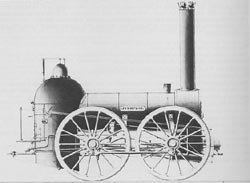 |
In 1837 Edward Bury of Bury Curtis & Kennedy of Liverpool was appointed Locomotive Superintendent of the London to Birmingham railway with his headquarters at Wolverton. However, as Wolverton was simply considered to be a repair shop for the engines his Liverpool firm supplied to run on the line, he left the running of the Works to his Shop Foreman. |
| Bury Engine Science Museum | |
| In September 1838 the whole line from London to Birmingham was opened and it can be said that it was then that Wolverton Works was really born. It became necessary for expansion to take place to accommodate, service and repair the increased number of trains and a large engine shed was built, said to be cathedral sized, together with all supporting facilities which also enabled the Works to produce, in house, their first two locomotives in 1854. | 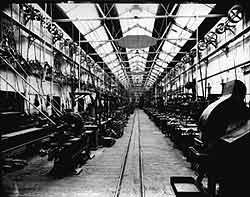 |
|
Fitting shop
|
|
| J E McConnell was appointed Superintendent in 1847 and Wolverton expanded. 1849 saw McConnell build his first locomotive at Wolverton, the prototype of the 'Bloomer' class (the wheels and works being more exposed the engines became know as Bloomers after Mrs Amelia Bloomer who was trying to reform ladies dress). During his time at Wolverton he made many innovations such as train heating, failsafe braking, hollow axles, boilers, fireboxes etc. Early in 1851 the first Bloomer engines were running (a replica Bloomer is on display outside Milton Keynes station). | |
| During 1852 McConnell was appointed Consulting Engineer to the Sydney Railway Co whilst still at Wolverton and in 1854 four locomotives were sub-contracted to be built that were copies of the Wolverton goods engines. After being dismantled these were shipped to Australia accompanied by a Shop Foreman from Wolverton. As can therefore be seen Wolverton had a hand in the first Australian railways. | |
| In 1859 thirty four engines were transferred from Crewe to Wolverton which involved further expansion of the Works. Under McConnell the Works flourished but unfortunately for him Mr Richard Moon was appointed Chairman of the Company and there was a clash of personalities resulting in McConnell retiring. A year or two after his retirement the engineering works were transferred to Crewe. Before the transfer to Crewe 165 engines had been built at Wolverton. | |
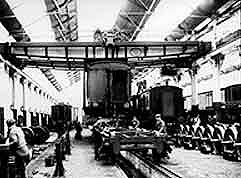 |
Expansion of the Works again took place during 1864 when Wolverton became the Carriage Works for the L & NWR and the manufacturing shops were converted to enable carriages to be built, painted and repaired. In 1869 two Royal Saloons for Queen Victoria were built at Wolverton. Sadly in 1872 the locomotive shop finally closed and Wolverton became exclusively a carriage works until in 1877 it was the largest in Britain. |
| Lifting Shop | |
| During the 1914-18 war the Works altered carriages to be used as ambulance trains for home and abroad. Their war work also included working for the Ministry of Munitions. During and between the wars all sorts of things were made at the Works and once again the 1939-45 conflict meant that ambulance trains were in demand together with armoured vehicles, mobile kitchens, wings for the Horsa gliders, assault boats and, unusually, Whitley bombers were sent for repair. | 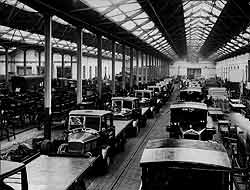 |
| Paint Shop | |
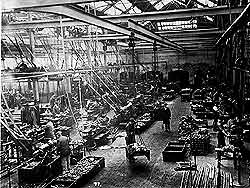 |
Unfortunately for the Works Dr Beeching and his plans came along and in 1962 it was relegated to a repair shop only with the last new vehicle being completed in 1963. Within a year the workforce had dropped from 4000 to 2000. |
| Lifting Shop | |
| By 1964 the Works were repairing Electrical Multiple Units but in February 1986 when British Rail Engineering Ltd split into two sections Wolverton became part of BR Maintenance Group working exclusive for BR which resulted in the loss of further jobs which left a workforce of approximately 850 staff.
By 1987 Wolverton Works had again been slimmed down to a depot status and since then a large part of the site has been sold off for redevelopment as a supermarket and car showrooms. |
|